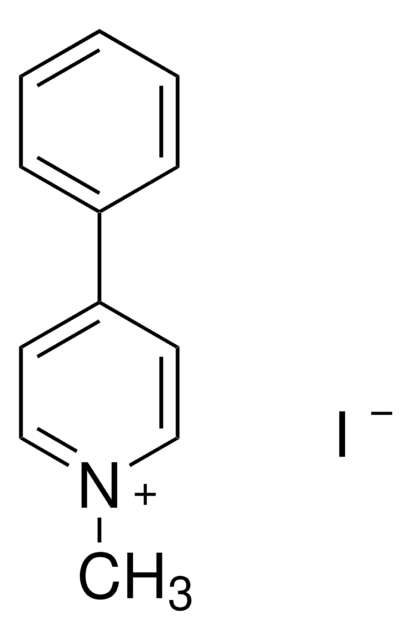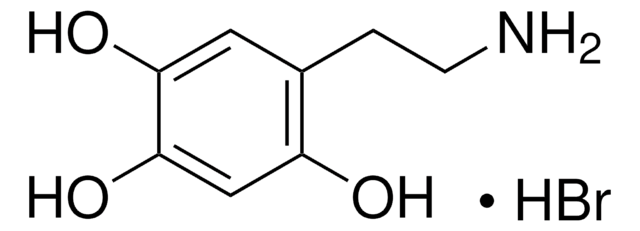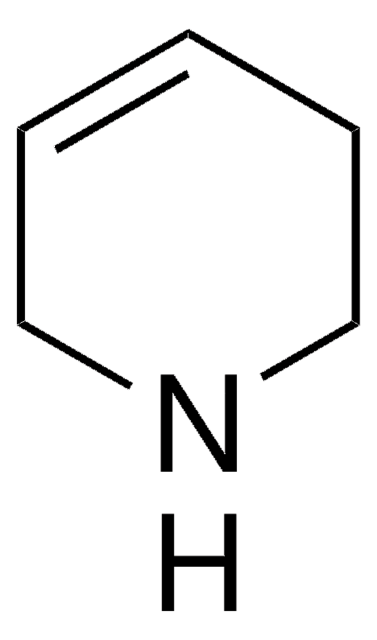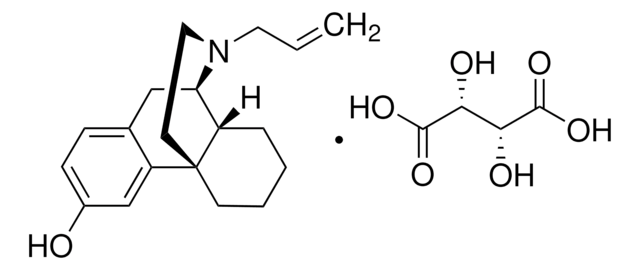M0896
MPTP Hydrochloride
≥98% (AgNO3), powder, dopaminergic neurotoxin
동의어(들):
MPTP HCl, Pyridine, 1,2,3,6-tetrahydro-1-methyl-4-phenyl-, hydrochloride, MPTP hydrochloride
로그인조직 및 계약 가격 보기
모든 사진(1)
About This Item
실험식(Hill 표기법):
C12H15N · HCl
CAS Number:
Molecular Weight:
209.72
Beilstein:
3707312
MDL number:
UNSPSC 코드:
12352200
PubChem Substance ID:
NACRES:
NA.77
추천 제품
product name
1-Methyl-4-phenyl-1,2,3,6-tetrahydropyridine hydrochloride, powder
형태
powder
drug control
kontrollierte Droge in Deutschland
색상
white to off-white
SMILES string
Cl[H].CN1CCC(=CC1)c2ccccc2
InChI
1S/C12H15N.ClH/c1-13-9-7-12(8-10-13)11-5-3-2-4-6-11;/h2-7H,8-10H2,1H3;1H
InChI key
KOWJANGMTAZWDT-UHFFFAOYSA-N
유사한 제품을 찾으십니까? 방문 제품 비교 안내
일반 설명
MPTP shows its effects by causing inflammation, excitotoxicity, mitochondrial apoptosis, formation of inclusion bodies, and oxidative stress that leads to dopaminergic neuronal damage in the striatum and substantia nigra. In dopaminergic neurons, MPTP blocks the mitochondrial complex I which leads to mitochondrial dysfunction.
애플리케이션
1-Methyl-4-phenyl-1,2,3,6-tetrahydropyridine hydrochloride has been used to induce Parkinson′s disease (PD) in animal models:
- to study the effect of docosahexaenoic acid on the apelin distribution of the nervous system
- to study the behavioral impairments correlated to neurochemical deficits
- to study the effects of treadmill exercise on neuroprotection and neuroinflammation
MPTP has been used to study its effects on microglial innate immune memory. It has also been used to study the protective effects of phenylpropionamides in Pakinson’s diseased mice models.
생화학적/생리학적 작용
1-Methyl-4-phenyl-1,2,3,6-tetrahydropyridine (MPTP) is a piperidine derivative and dopaminergic neurotoxin, useful in neurological research. MPTP is metabolized to 1-methyl-4-phenylpyridine (MPP+), which in turn can cause free radical production in vivo and lead to oxidative stress. Thus MPP+ is generally acknowledged as the active metabolite of MPTP. MPTP is widely used in in vivo research studies as a model for Parkinsonism. A review describes the application of MPTP in studies related to programmed cell death in neurogenerative diseases.
Dopaminergic neurotoxin.
경고
Reportedly causes a severe and irreversible Parkinsonian condition in humans and monkeys.
신호어
Danger
유해 및 위험 성명서
Hazard Classifications
Acute Tox. 3 Oral - STOT SE 1
표적 기관
Nervous system
Storage Class Code
6.1C - Combustible acute toxic Cat.3 / toxic compounds or compounds which causing chronic effects
WGK
WGK 3
시험 성적서(COA)
제품의 로트/배치 번호를 입력하여 시험 성적서(COA)을 검색하십시오. 로트 및 배치 번호는 제품 라벨에 있는 ‘로트’ 또는 ‘배치’라는 용어 뒤에서 찾을 수 있습니다.
이미 열람한 고객
Yi-Kai Jiang et al.
Fitoterapia, 175, 105883-105883 (2024-03-09)
Parkinson's disease (PD) is the second most common neurodegenerative disease in the world. As one of the major degradation pathways, autophagy plays a pivotal role in maintaining the effective turnover of proteins and damaged organelles in cells. Lewy bodies composed
Musa Mustapha et al.
Bosnian journal of basic medical sciences, 21(4), 422-433 (2020-12-29)
Among the popular animal models of Parkinson's disease (PD) commonly used in research are those that employ neurotoxins, especially 1-methyl- 4-phenyl-1, 2, 3, 6-tetrahydropyridine (MPTP). This neurotoxin exerts it neurotoxicity by causing a barrage of insults, such as oxidative stress
Hypoxia inducible factor-1? regulates microglial innate immune memory and the pathology of Parkinson?s disease
Dong, et al.
Journal of Neuroinflammation (2024)
Detection of behavioral impairments correlated to neurochemical deficits in mice treated with moderate doses of 1-methyl-4-phenyl-1,2,3,6-tetrahydropyridine
Tillerson JL, et al.
Experimental neurology (2002)
Treadmill exercise alleviates neuronal damage by suppressing NLRP3 inflammasome and microglial activation in the MPTP mouse model of Parkinson's disease
Wang W, et al.
Brain Research Bulletin (2021)
자사의 과학자팀은 생명 과학, 재료 과학, 화학 합성, 크로마토그래피, 분석 및 기타 많은 영역을 포함한 모든 과학 분야에 경험이 있습니다..
고객지원팀으로 연락바랍니다.












